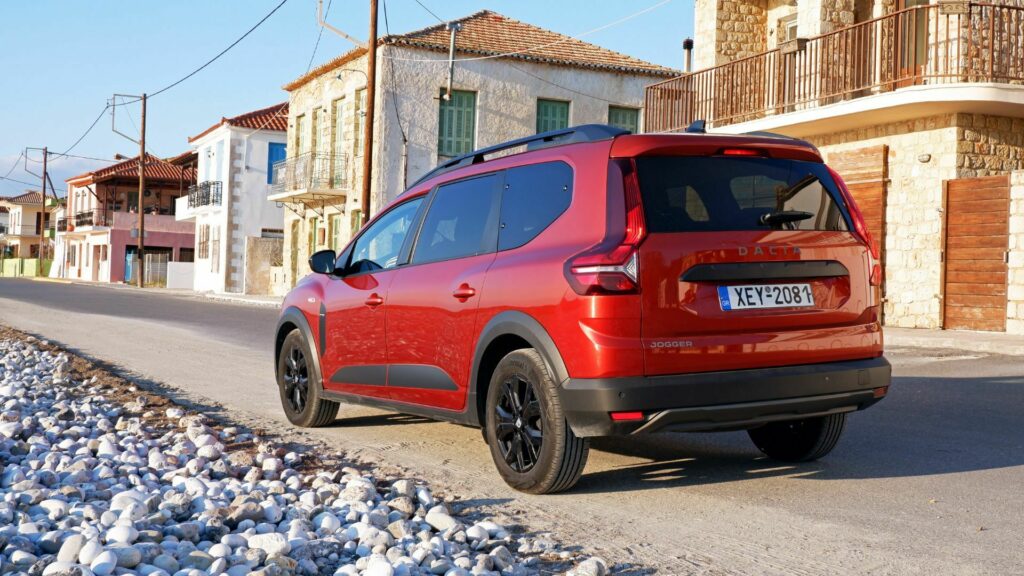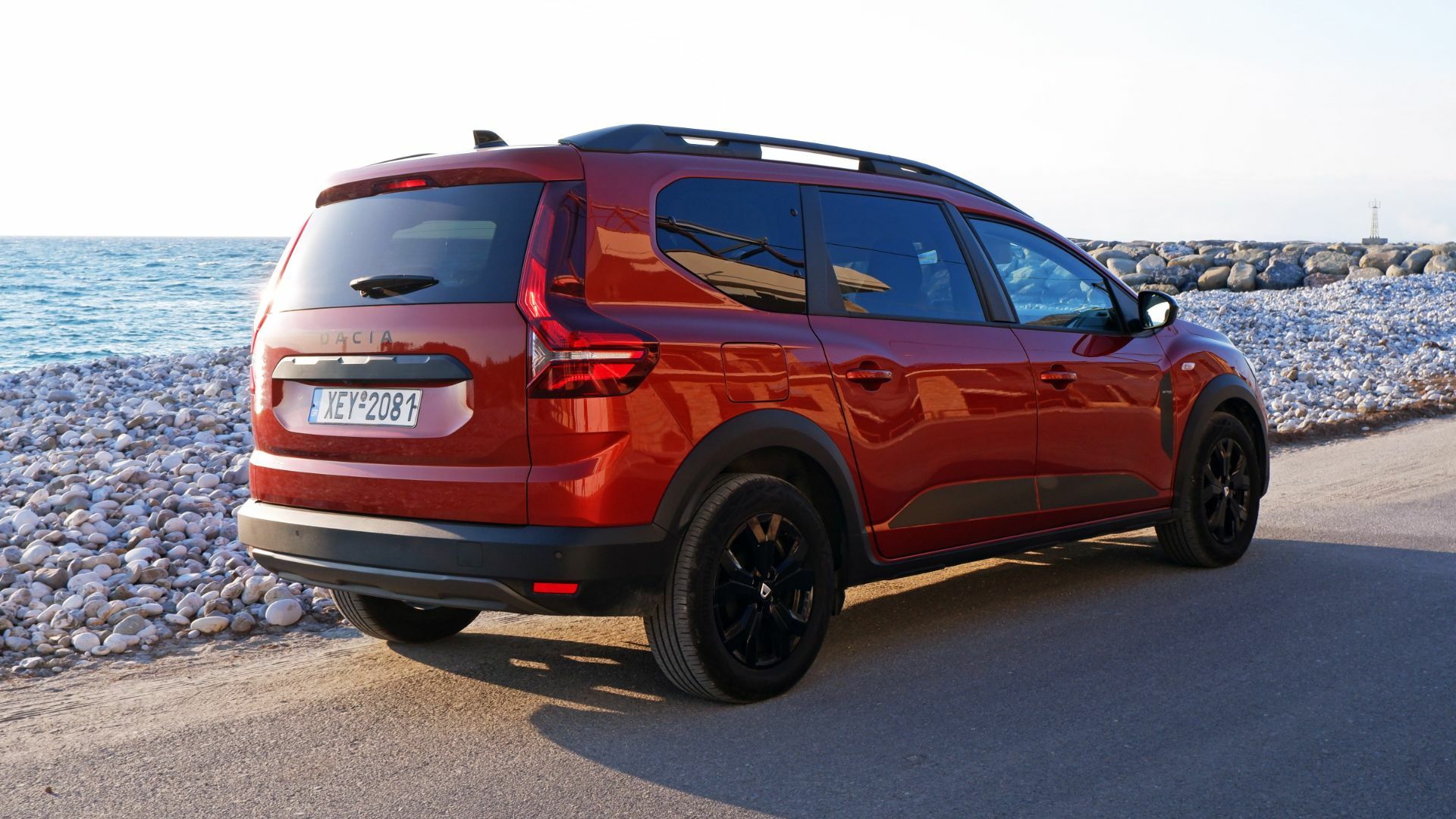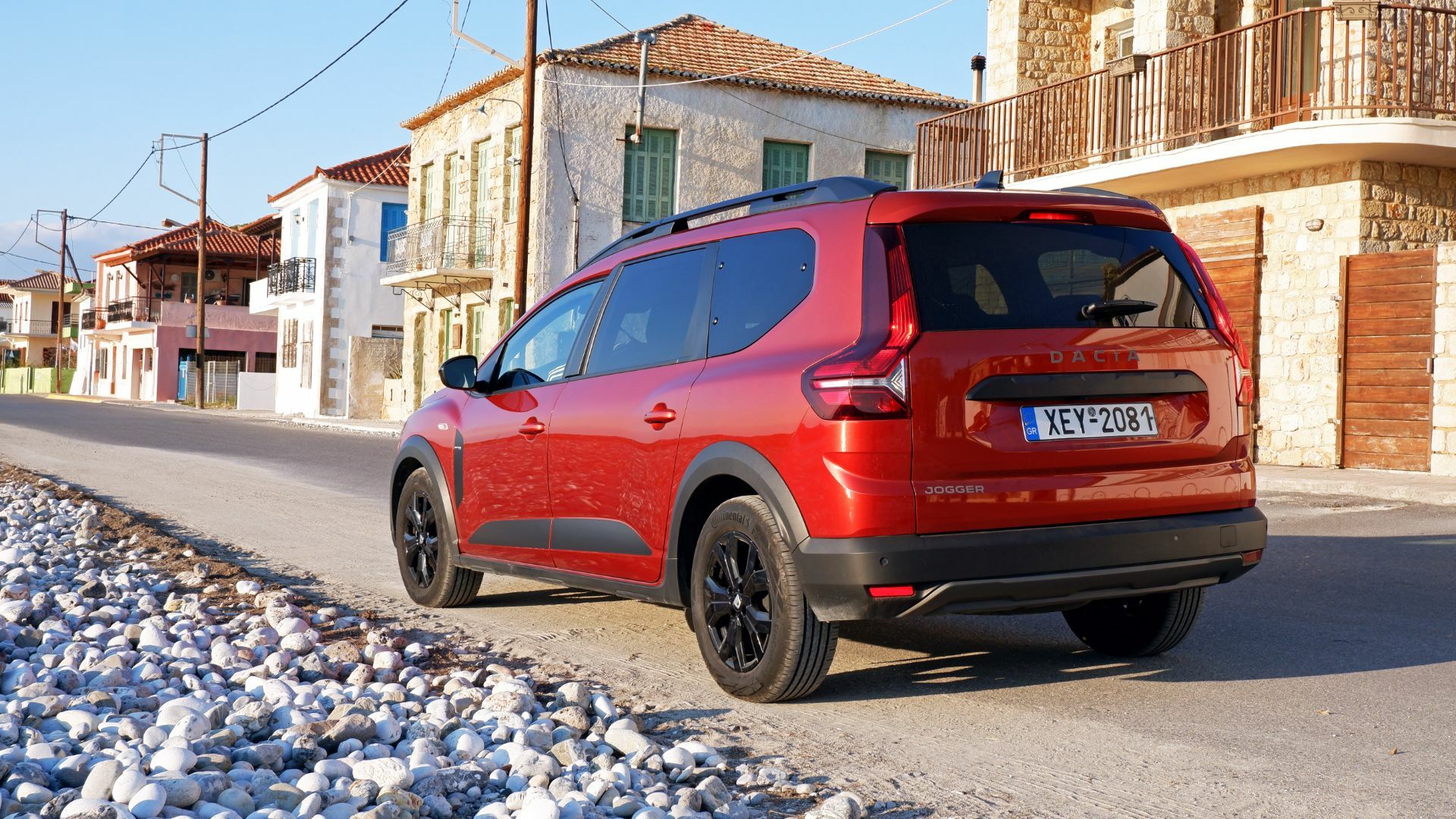In a world where affordable family cars are an endangered species, Dacia took advantage of Renault Group’s parts bin, creating one of the cheapest seven-seaters in Europe. Surprisingly, the Dacia Jogger is not an LCV-based minivan but more a more modern crossover station wagon that is available with petrol, LPG, and hybrid powertrains. We recently got the keys to the bi-fuel version, in order to test its practicality and value-for-money credentials.
Dacia introduced the Jogger in 2021, but updated it with its new branding in 2022 alongside the rest of the lineup. The Jogger we’re driving left the factory before the early facelift, which explains the old grille and emblem. At least it is the full-spec Extreme Limited Edition with all the goodies. Mind you, the popularity of flagship trims prompted Dacia to reintroduce the Extreme with slightly different color combinations for 2023, and expand it to more models.
Long As A Wagon And High As A Crossover
When looked at from the front, the Jogger can be easily mistaken for a Sandero Stepway, as the mechanically-related models share the same facial features. However, a glimpse at the profile reveals that the Jogger is significantly longer and slightly taller than the Sandero, making it clear we are talking about a standalone model and not a bodystyle variant. This is even more evident at the back, where the Volvo-style taillights look like no other Dacia and the nearly vertical cut of the large tailgate communicates its focus on practicality.
Luckily, the Jogger doesn’t have the hearse-style look of some station wagons, as most of the extra length goes into the stretched wheelbase and not in the rear overhang. In fact, the 2,897 mm (114 inches) wheelbase is a full 293 mm (11.5 inches) longer than the Sandero, while the length of 4,547 mm (179 inches) is 206 mm (8.1 inches) longer than the Duster. This makes the Jogger the new king of the Dacia range in terms of footprint, at least until the Bigster flagship SUV arrives next year. Furthermore, the plastic cladding in combination with the modular roof rails and the generous 200 mm (7.8 inches) ground clearance enhance the crossover stance of the FWD-only model, while the latter makes it harder for its belly to scrape on soft off-roading courses.
Roomy And Modular Cabin
Moving inside, the stretched wheelbase immediately shows its merits as it allowed Dacia designers to add three properly-sized seats on the rear bench which is significantly wider than the one in the Sandero / Logan. This was made possible by moving the rear wheels further to the back and certainly adds practicality points to the model. The same applies to the taller roof which results in heaps of headroom for the rear passengers that sit higher than those in the front, enhancing the visibility and the airy feeling of the cabin.
Generally speaking, practicality is close to that of traditional minivans, with fold-out tables on the seatbacks, cupholders for all passengers, and 20.1 lt (0.7 cubic feet) of in-cabin storage. However, the highlight of the Jogger is the optionally available seven-seater layout (2+3+2). The two extra seats at the boot are foldable and easily removable so buying the three-row Jogger doesn’t mean you have to permanently compromise boot space.
Access to the third row proved to be easier than I expected and the space back there is more than adequate for an average-sized adult. I am 6.04 ft tall and I had enough headroom, slightly limited legroom, and great visibility due to the generously-sized rear windows. Those who want the maximum available legroom can fold the second row and transform the Jogger into a budget-friendly four-seater limo (more about that in a separate story).
Dacia says there are more than 60 combinations in terms of seating layouts, prioritizing passenger or cargo space according to your needs. During my time with the Jogger, I enjoyed the modularity of the cabin, and how easy it was to create the desired layout for the occasion. The ample space allowed me to take my extended family on a 30-minute trip, carrying a driver, five adults, a baby on its dedicated seat, and a few small bags of luggage without any problems or complaints.
The only downside is the tiny boot of 160 lt (5.7 cubic feet) when all seven seats are in place, meaning that a family of seven will need a roof box for longer trips. Still, this was to be expected from a 4,547 mm (179 inches) long vehicle that is based on a supermini platform. Another thing is that while it is easy to remove the third row, if you want to keep them folded in the car there is a big gap with the boot floor, making all that space kind of impractical.
Still, if you take the extra step and leave your two extra seats at home, you get access to an impressive 696 lt (24.6 cubic feet) of cargo space which is more than most people would ever need in a passenger vehicle. This makes it possible to install Dacia’s brand-new €1,490 ($1,589) Sleep Pack accessory that converts the Jogger into an all-around camper, especially if you combine it with the rear tent extension. Finally, if you also fold the second row, the Jogger transforms into an LCV impersonator, offering a massive 1,807 lt (63.8 cubic feet) of cargo space. Note that all the aforementioned figures were measured with the VDA method.
Hard Plastics, Essential Equipment
The dashboard looks familiar to Dacia fans as it is carried over from the Sandero Stepway. This means it has the same hard scratchy plastics, although it is hard to expect something different from such an affordable offering. Entry-level models come with a simple smartphone dock, but high-end versions like the one we drove come standard with a free-standing 8-inch touchscreen for the rather basic infotainment system which thankfully supports wireless Android Auto / Apple CarPlay. There is also a slightly squeaky built-in smartphone holder between the infotainment and the instrument cluster, and a handy USB-C charging port behind it for charging your device.
Other features in the Extreme trim include the auto climate control with the widely used Renault-sourced dials, a worse-than-average six-speaker audio system, and dashboard inserts that look like the carpet of a ferry boat. Thankfully the latter has been replaced by the wear-resistant and easy-to-clean MicroCloud material in the 2023 model. Don’t expect any fancy digital instrument cluster though since all Jogger trims get analog dials and a basic trip computer from the ‘90s.
An important downside is the lack of ADAS which resulted in a single-star EuroNCAP safety rating for the Jogger that might be a deal-breaker for some buyers. The Romanian automaker insists that its customers do not want systems like the lane departure warning, so they saved money by not offering them at all. In fact, driving aids in the flagship trim are limited to auto headlights/wipers, automatic braking, parking sensors, hill-start assist, a rear-view camera, and an optional blind spot warning. Personally, while I understand the need of keeping the price low, I am more appreciative of companies like Toyota and Suzuki who offer a pretty generous ADAS suite as standard in all trims independently of the segment.
Comfortable Ride, Noisy Engine, Slow When Loaded
The Dacia Jogger is based on the longest available version of Renault Group’s CMF-B architecture. The ride is quite comfortable even though it lacks the refinement of the mechanically-related Renault Captur. The higher center of gravity and increased weight compared to the Sandero brings a healthy amount of body roll although not enough to scare the driver at any point. The steering is light and doesn’t have much feedback, but this is not much of a problem as the overall setup is not destined for attacking B-roads. Despite the absence of rear discs (all variants come with rear drums), brakes proved to be sufficient even when the car was loaded. In the city, the Jogger is easier to maneuver than you would expect and feels more like a supermini than a three-row crossover. The large windows offer excellent visibility for all passengers, with the parking sensors and rear-view camera of the flagship trim coming in handy when navigating in tight parking spaces.
The tiny turbocharged 1.0-liter three-cylinder engine under the bonnet is compatible with both LPG (liquid petroleum gas) and regular petrol. While the numbers suggest a difference in the output and torque figures depending on the type of fuel used, this is barely noticeable when driving. The mill produces 99 hp (74 kW / 100 PS) and 170 Nm (125 lb-ft) of torque when running on LPG, or 90 hp (67 kW / 91 PS) and 160 Nm (118 lb-ft) when running on petrol. The heavier seven-seater variant needs 13 seconds (LPG) or 13.2 seconds (petrol) for the 0-100 km/h (0-62 mph) sprint, but the short gearing of the six-speed manual gearbox and the low-end torque of the engine makes it feel zippier in real life and sluggish only when fully loaded.
On the highway, if you carry passengers you don’t have the confidence of overtaking, but the powertrain is capable of reaching and consistently sustaining speeds of 140 km/h (87 mph) without any problems. There is a bit of aerodynamic noise, but not enough to compromise the passenger’s well-being on longer journeys. The sound of the engine in higher revs can be irritating at times, due to the lack of insulation materials, but thankfully you can keep it quiet using the last gear of the six-speed manual transmission.
The recently revealed Dacia Jogger Hybrid should be a better option for those interested in performance figures as the quickest and most powerful variant of the Jogger. Still, the extra cost of electrification might not be worth it in this particular type of vehicle as it will certainly limit its value-for-money credentials.
Cheaper To Run Than A Diesel
And now we covered its driving manners let’s talk about running costs. You can choose the preferred fuel from a dedicated button, but in reality, you will be driving with LPG for as much as possible since petrol is twice more expensive, at least with the current prices. Thus, given that you have access to the LPG network, the Jogger can be both cheaper to run and cleaner than your average non-electrified car with significant benefits in the long term.
Filling up the 40-liter (10.6 gallons) LPG tank required around €32 ($34) in Greece, although if you live in other countries it could be less than €20 ($21.3). The LPG range we got was around 360 km (224 miles) with an average consumption of 11 lt/100 km (21.1 mpg) mainly on the highway, although we could go further than that with a more careful use of the gas pedal. Dacia’s claimed average WLTP consumption of 7.8 lt/100 km (30 mpg) would be hard to achieve, though, especially in a vehicle that is often loaded.
When the LPG tank is empty, you can rely on the regular-sized 50-liter (13.2 gallons) gas tank which required around €90 ($95.8) to fill up with the current prices in Greece. Again, fuel consumption is higher than your typical 1.0-liter supermini due to the heavier body of the Jogger, so I would expect something closer to 8.5 lt/100 km (27.7 mpg) in everyday life rather than the advertised WLTP figure of 5.7 lt/100 km (41.20 mpg). In any case and depending on the driving style, the combined petrol and LPG range can be 900-1,000 km (560-621 miles) for those who don’t like refueling stops.
Pricing And Rivals
When it was originally introduced last year, the Dacia Jogger LPG started from as low as €18,880 ($20,108) for the five-seater Essential and went up to €23,780 ($25,326) for the seven-seater Extreme making it a crazy deal for a family hauler. Unfortunately, the inflation in the automotive industry led to a price increase for the slightly updated Jogger which ranges from €23,930 ($25,486) for the five-seater Expression up to €28,180 ($30,013) for the seven-seater Extreme flagship (for the bi-fuel powertrain).
Still, if we exclude LCV-based proposals, the Dacia Jogger is playing without any rivals in terms of seven-seater capability at this price point. The closest competitor with a similar bodystyle is the Fiat Tipo SW Cross although it is more expensive starting at €35k ($37,2k) and only comes with five seats. As for SUVs, the cheapest one that offers an optional seven-seater capability is the Skoda Kodiaq which starts from €32.4k ($34.5k).
Alternatively, if you don’t really care about the crossover stance and just need the maximum practicality, you can buy an LCV-based minivan. Options are limited after Stellantis decided to discontinue their ICE variants and go EV-only in Europe, but there is the seven-seater Toyota ProAce City starting from as low as €22-23k ($23.4-24.5).
Verdict
The Dacia Jogger is an excellent choice for those who want a practical and affordable family hauler with loads of interior space, a comfortable ride, and an adventurous stance.
The crossover station wagon bodystyle is more appealing to most buyers than a typical LCV-based minivan which is the only alternative with an equal number of seats in this price range. Indeed the seven-seater option is a major selling point for the Jogger, as the adult-friendly third row might compromise boot space but is easily removable. Other than that, the spartan character of the cabin is not much of an issue, although the lack of ADAS is a drawback by 2023 standards.
The bi-fuel variant sounds like the best fit for the Jogger’s character, with the LPG offering half the running cost compared to regular petrol given you have access to a compatible gas station. Performance is adequate in most cases, while the tiny turbocharged engine will struggle and make noise only when the car is fully loaded.






























































































